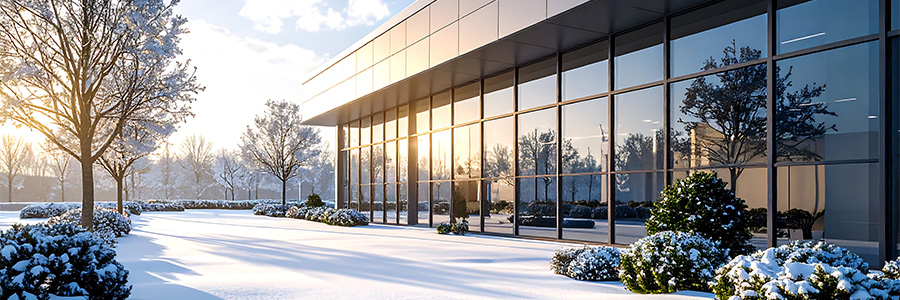
Although lawns and plants of Summer will go dormant in the Fall to conserve their energy before the long, frigid months of Winter, it’s vital that landscape maintenance continues to prepare for Spring thaw to come. That means pruning, trimming—as well as planting and caring for new Winter landscapes.
Maintaining Landscapes Before Winter Sets In
Trim Overgrown Shrubs and Prune Trees. As plants begin to wither and fade during dormancy, trimming and pruning are important to keep them from developing diseases.
Trees and overgrown shrubs should be pruned to avoid limb loss during heavy rain and snow. Perrenial stems should be cut back one to two inches from the ground surface to keep the plants from dying.
Mulch Around Plants to Promote Root Growth. To increase the nutrient supply around plants for root growth during Winter, add light mulching, such as straw, pine needles, hay or fertilizer around plants. Plants will grow stronger, fuller and greener for Spring.
Aerate Turf Before Winter Sets In. To give turf breathing room during change of seasons, break up compacted soils. Aerating allows moisture and nutrients to seep deeper down into the roots of grass, plants and trees, for a lush and healthy landscape come Spring.
Winterize Irrigation System. Pipes filled with frozen water will crack and burst, and cause major damage to an irrigation system. During the time an irrigation system is winterized, turf and plants should be watered by hand to maintain a commercial property’s curb appeal. Property managers should never turn the irrigation system back on during Winter months without professional assistance.
Tips for Creating an Elegant Winterscape
Add New Plants for Color. Aside from keeping trees and plants healthy by pruning and trimming ahead of Winter, adding new plants will create an elegant Winterscape to spruce up a business property’s curb appeal with pops of merry holiday color and texture.
Plant Ornamental Trees. They may lose their leaves, but their interesting, unique bark will add color and texture against a stark, snowy Winterscape. Ornamental trees with interesting bark to consider:
- Japanese Maple
- Lacebark Pine
- River Birch
- Dogwood
- Paper Birch
- Manchurian Fir
- Seven-Son Flower
Plant Evergreen Trees. Placed here and there around the property, Evergreen Trees offer towering bursts of green against a snowy Winterscape. Since they keep their foliage throughout the coldest, darkest days of Winter, Evergreens lend a feeling of life to a stoic Winterscape.
Add Plants with Winter Berries. Plants with berries add festive pops of holiday color to a snowy Winterscape. The berries will also attract birds and wildlife to feed off of them for sustenance during harsh Winter months, benefiting the eco-system.
Some plants with winter berries to consider:
- Rose Hips
- Wintergreen
- Holly
- Cotoneaster
- Juniper
- Sea Buckthorn
Lawn Care When Frost Sets In
As mild Fall days begin to fade, and frost begins to appear in the morning, moisture on grass and plants will freeze. Even a light frost over several nights can lead to damage of a lawn.
Bermuda lawns become brown and patchy, and quickly die if temperatures don’t warm back up. St. Augustine grass turns brown, yellow or purple when grass blades are damaged by frost.
Each grass blade is essentially frozen. If you walk on a frozen lawn, the blades will break from the weight of your footsteps, causing more damage to grass blades at the cellular level than frost alone. So to prevent further damage to frozen grass before Spring arrives, it’s important never to walk on a frozen lawn.
As the warmth of Spring exhales at last to begin melting away Winter’s mantle of snow and frost, lawn care begins anew. Spring may start end of March, but local weather conditions will determine when it’s safe to turn the irrigation system back on again. Turning it on too early can damage the irrigation system if there is still a threat of frost, and nighttime temperatures are still dropping below freezing.
Once local temperatures remain above freezing both day and night, the irrigation system can be activated—typically between late April and May. If it’s a rainy Spring, it can even wait until late May, as regular watering isn’t usually necessary until early June.
The WeatherTRAK LC+ can easily manage a single, light-commercial property or hundreds of sites. Utilizing sophisticated automation technology, this powerful Smart Irrigation Controller eliminates water waste based on real-time, site-specific data from the ET Everywhere weather service to irrigate only when necessary, using less water while keeping landscapes looking great.
When it comes to soil moisture levels deep beneath the ground surface, Baseline’s biSensor Soil Moisture Sensors can measure soil moisture where it matters most, in the root zone of plants. Using patented technology, bisensors save money because they reduce water usage—up to 62% or more over traditional irrigation methods. These ultra-sensitive sensors can take soil moisture readings within + 3 percent of the actual volumetric soil moisture content around plants, convert the measurement to a soil moisture content reading, and electronically send it to the Smart Controller for the best irrigation decisions possible.
The worst thing a commercial business can do is put off basic landscaping tasks in Winter until the warmer days of Spring. In order for a commercial landscape to look robust, lush and healthy in the Spring, it is important to include Winter landscaping in a company’s budget during Winter months to protect the business investment, as well as its public image.

